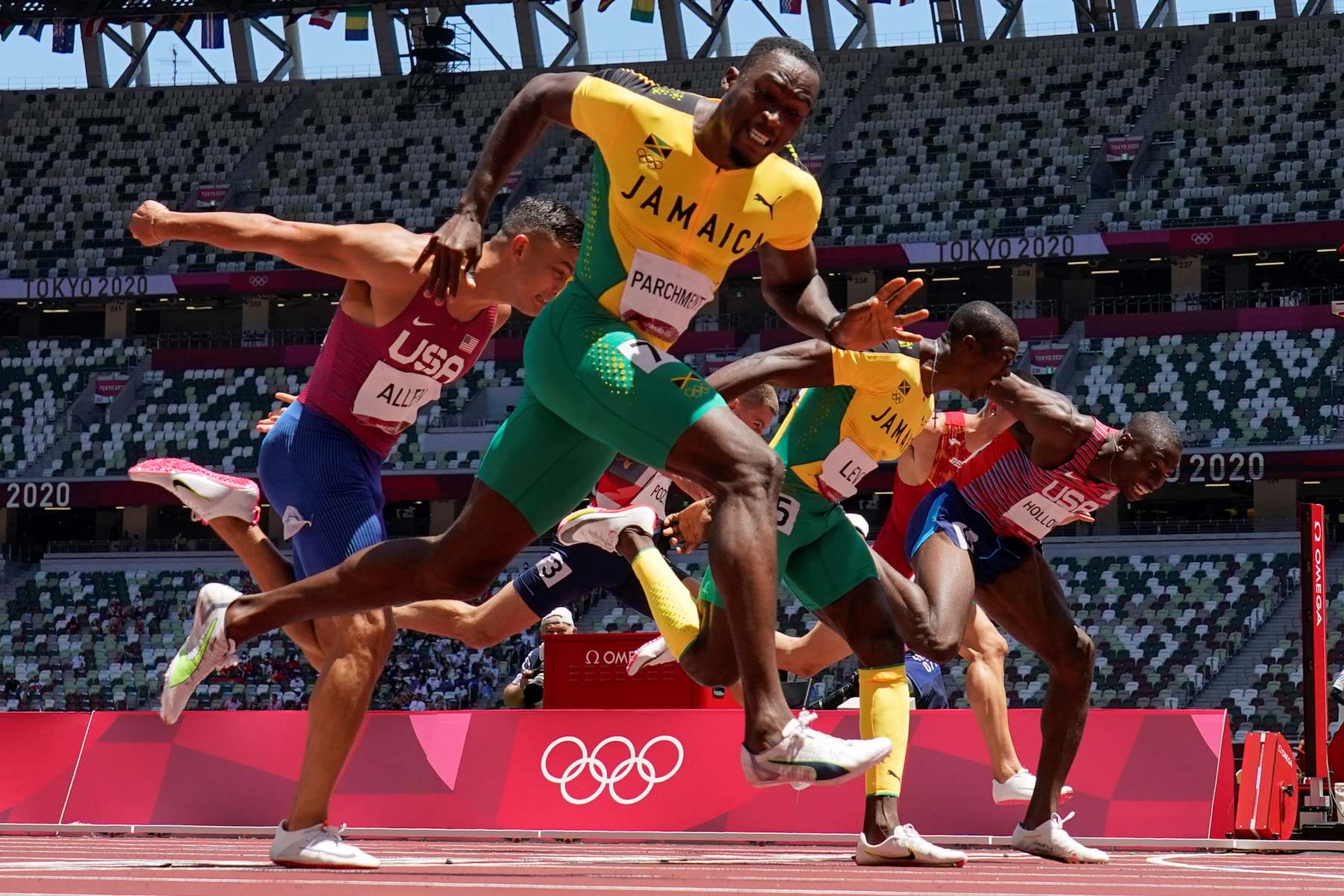

Featured
What Does NH Mean In Track And Field
Modified: January 2, 2024
Find out what "NH" means next to featured athletes' names in track and field, along with its significance and implications.
Introduction
Welcome to the exciting and dynamic world of track and field! As an avid observer of the sport, you may have noticed the abbreviation “NH” next to athletes’ names during competitions. But what does “NH” actually mean and why is it significant? In this article, we will explore the meaning of “NH” in track and field, its common occurrences, and the possible reasons behind it.
Track and field is a sport that encompasses various athletic events such as sprints, jumps, throws, and distance running. Athletes strive to achieve their best performances in each event, and their results are recorded and displayed for spectators and participants to see. However, sometimes you may come across the abbreviation “NH” next to an athlete’s name, indicating a particular outcome or event occurrence that deserves further attention.
Understanding the meaning of “NH” is crucial to comprehending the performance of track and field athletes. Knowing its significance can provide insights into an athlete’s abilities, tactics, or even their chances of breaking records. So, let’s delve deeper into the world of “NH” in track and field and uncover the fascinating details behind this cryptic abbreviation.
Explanation of “NH” Abbreviation
Now that we have piqued your curiosity about the meaning of “NH,” it’s time to uncover the mystery behind this abbreviation. In track and field, “NH” stands for “No Height” or “No Height Record.” It indicates that an athlete has failed to clear the bar or achieve a valid height in an event such as high jump or pole vault.
During high jump and pole vault competitions, athletes aim to clear a bar that is set at progressively higher heights. They must use their skill, technique, and athleticism to launch themselves over the bar without touching it. However, if an athlete fails to clear the bar in all of their attempts, the result is recorded as “NH.”
“NH” is used as a standardized abbreviation across various track and field events to denote a failed attempt or a foul. It is a consistent symbol used by officials and organizers to keep track of athletes’ performances and keep the competition organized and fair.
It’s essential to remember that “NH” doesn’t necessarily indicate a lack of talent or effort on the part of the athlete. Track and field events require precision, focus, and split-second timing, making them incredibly challenging. Even the most accomplished athletes may experience failed attempts, and “NH” is simply a record of their unsuccessful performance on a specific occasion.
NH Meaning in Track and Field
The meaning of “NH” in track and field extends beyond just indicating a failed attempt. It carries significance within the context of the sport and provides valuable information about an athlete’s performance. When you see “NH” next to an athlete’s name, it signifies that they were unable to achieve a height or distance that would be counted towards their overall result in the event.
In events like high jump and pole vault, athletes have a certain number of attempts to clear the bar at each height. The bar is gradually raised, increasing the challenge for the athletes. If an athlete fails to clear the bar in any of their attempts, “NH” is recorded next to their name.
The presence of “NH” suggests that the athlete was unsuccessful in meeting the requirements of the event. It may indicate a lack of clearance over the bar, inability to maintain form during the attempt, or even a technical fault leading to a foul. Regardless of the specific reasons, “NH” implies that the athlete did not achieve a valid height or distance within the rules of the event.
The meaning of “NH” extends to other track and field events as well. For instance, in long jump and triple jump, “NH” is used to denote a failed attempt where the athlete did not achieve a legal jump. Similarly, in throwing events like shot put and discus, “NH” is used when an athlete fails to achieve a valid distance due to a throw that goes outside the designated landing area.
Understanding the meaning of “NH” helps spectators, coaches, and athletes themselves in evaluating a performance. It allows for accurate recordkeeping and ensures that the rules and regulations of each event are upheld. It also provides a reference point for athletes to analyze their performances, identify areas for improvement, and strategize for future competitions.
Common Occurrences of NH Next to Athletes’ Names
As you observe track and field events, you may notice that the abbreviation “NH” appears frequently next to athletes’ names. It is a common occurrence due to the nature of the sport and the inherent difficulty of clearing heights or achieving valid distances. Let’s explore some of the common situations where “NH” is seen.
- High Jump and Pole Vault: In these events, athletes aim to clear a bar set at increasing heights. “NH” is often recorded when an athlete fails to clear the bar in all of their attempts. It can happen due to technical errors, lack of sufficient power or speed, or a miscalculation in the approach.
- Long Jump and Triple Jump: In these events, athletes strive to achieve a legal jump by landing within the designated area. When an athlete fails to meet the requirements, such as stepping over the take-off board or landing outside the pit, “NH” is recorded.
- Shot Put and Discus: Throwing events involve athletes aiming to achieve a valid distance within a designated throwing area. If an athlete fails to throw the implement within the specified sector or if it goes outside the landing area, “NH” is recorded.
- Failed attempts during record-breaking performances: When athletes attempt to break world records or achieve personal bests, they often take more risks and push their limits. This can lead to a higher frequency of failed attempts, resulting in “NH” being recorded.
It’s important to note that the occurrence of “NH” doesn’t diminish the significance of an athlete’s performance. On the contrary, it highlights the challenges and the level of competition that athletes face in track and field. Even the most accomplished athletes experience “NH” from time to time, underscoring the unpredictable nature of the sport.
By understanding the common occurrences of “NH,” spectators can gain a deeper appreciation for the dedication and skill required in the various track and field events. It serves as a reminder that success in this sport often comes after multiple failures, and each “NH” represents a learning opportunity for athletes to improve and strive for greater heights in their future endeavors.
Possible Reasons for NH Next to an Athlete’s Name
When “NH” appears next to an athlete’s name in track and field, it signifies that they were unable to achieve a valid height, distance, or outcome in their respective event. Several factors contribute to this outcome, and understanding these reasons can provide insights into why “NH” is recorded next to their name. Let’s explore some possible explanations for the occurrence of “NH.”
- Lack of Technique: Track and field events require athletes to execute precise and complex techniques. In high jump and pole vault, for example, a slight misstep or incorrect body position can result in a failed attempt and “NH” being recorded.
- Inadequate Power or Speed: Clearing heights or achieving longer distances often requires a combination of power and speed. If an athlete lacks the necessary strength and speed to generate enough force, they may fail to reach the desired mark and end up with “NH” next to their name.
- Miscalculation in Approach: Approach and takeoff are critical in various track and field events. If an athlete misjudges their approach, they may not be able to generate the proper momentum or the correct angle for clearing the bar or achieving the desired landing distance, resulting in an “NH.”
- Risk-Taking: Sometimes athletes opt to raise the bar to attempt record-breaking performances or personal bests. While the intention is to push their limits, this increase in difficulty can lead to a higher frequency of failed attempts and “NH” being recorded.
- Weather Conditions: Factors such as wind, temperature, or unfavorable weather conditions can affect an athlete’s performance. Strong gusts of wind, for example, can disrupt an athlete’s rhythm and timing, leading to unsuccessful attempts and “NH” next to their name.
- Nerves or Pressure: In high-stakes competitions, athletes may struggle with nerves and pressure, which can impact their performance. These psychological factors can result in technical errors, lack of focus, or a failed attempt, leading to the recording of “NH.”
It’s important to remember that experiencing “NH” does not define an athlete’s overall abilities or potential. The highly competitive and challenging nature of track and field often results in athletes pushing their limits, which can lead to failed attempts. Each “NH” serves as a valuable learning opportunity for athletes, allowing them to identify areas for improvement and refine their skills for future performances.
Impact of NH on an Athlete’s Performance
The presence of “NH” next to an athlete’s name can have both immediate and long-term impacts on their performance in track and field. Let’s explore the effects of “NH” on athletes and how it can influence their mental and physical game.
Psychological Impact: Seeing “NH” next to their name can be disheartening for athletes, especially if they had high expectations for their performance. It may lead to feelings of disappointment, frustration, or a blow to their confidence. Overcoming this setback requires mental resilience and the ability to learn from the experience rather than dwelling on the negative outcome.
Learning Opportunity: Each “NH” serves as a valuable learning opportunity for athletes. It allows them to analyze the factors that contributed to the failed attempt and identify areas for improvement. By studying their technique, approach, and mental state during the event, athletes can make adjustments, refine their skills, and come back stronger in future competitions.
Motivation and Determination: Experiencing “NH” can fuel athletes’ motivation and determination to improve. It serves as a reminder that success in track and field is not easily handed out, and that hard work, perseverance, and continuous development are necessary to achieve desired results. Athletes may use the disappointment of “NH” as fuel to push themselves harder in training and strive for success in their next performance.
Pressure to Perform: For some athletes, repeated instances of “NH” can create a sense of pressure to perform well in subsequent events. They may feel the need to prove themselves and overcome the previous setbacks. While this pressure can be challenging to handle, it can also push athletes to dig deep, focus on their strengths, and perform at their best.
Resilience and Mental Strength: Dealing with “NH” can develop an athlete’s resilience and mental strength. It teaches them how to bounce back from disappointment, stay focused on their goals, and maintain a positive mindset despite setbacks. The ability to quickly recover from a failed attempt and refocus on the next opportunity is a crucial skill that can propel athletes to future success.
Continuous Improvement: Athletes understand that setbacks and “NH” are part of the journey to excellence. The process of overcoming failures, analyzing performances, and making necessary adjustments is crucial for constant improvement. The “NH” serves as a reminder that there is always room for growth and development, leading athletes to work even harder to achieve their goals.
Although “NH” may initially be seen as a negative outcome, its impact on athletes’ performance can be transformative. With the right mindset and approach, athletes can turn the disappointment of “NH” into motivation, opportunity, and ultimately, success.
NH as an Indication of a Foul or Failed Attempt
When you see “NH” next to an athlete’s name in track and field, it often indicates a foul or a failed attempt. Understanding the significance of “NH” as an indication of a foul or unsuccessful performance is important in evaluating an athlete’s results. Let’s explore the implications of “NH” and how it relates to these occurrences.
Foul: In track and field events, certain rules and regulations must be adhered to in order for an attempt to be valid. If an athlete violates these rules during their performance, it results in a foul. Depending on the event, fouls can occur due to various reasons such as stepping over the take-off line, failing to clear the bar properly, or stepping out of the designated throwing area. When a foul is committed, “NH” is often recorded next to the athlete’s name to signify the unsuccessful attempt.
Failed Attempt: In addition to fouls, “NH” is also used to indicate a failed attempt where an athlete was unable to achieve a valid height, distance, or outcome. The reasons for a failed attempt can vary. It could be due to a technical error, lack of power or speed, miscalculation in approach, or unfavorable weather conditions. Regardless of the specific cause, “NH” serves as a record of the athlete’s unsuccessful attempt to meet the requirements of the event.
The presence of “NH” as an indication of a foul or failed attempt is crucial in track and field competitions. It allows officials, athletes, and spectators to track and evaluate the performance accurately. “NH” helps maintain fairness and consistency in adherence to the rules and regulations of each event.
Athletes should pay close attention to the occurrence of “NH” as it provides valuable feedback for improvement. By analyzing their fouls or failed attempts, athletes can identify areas of weakness, work on their technique, refine their approach, and avoid similar mistakes in future performances.
Furthermore, for officials and spectators, “NH” serves as a point of reference when assessing an athlete’s performance and comparing it with other participants. It provides a clear indication that the specific attempt did not meet the required standards and should not be counted towards the final result.
Overall, “NH” as an indication of a foul or failed attempt brings transparency and objectivity to track and field competitions. It showcases the importance of compliance with rules, accountability for performance, and the continuous pursuit of improvement for athletes striving to reach their full potential.
NH Usage in Different Track and Field Events
The usage of “NH” as a notation for unsuccessful attempts extends across various track and field events. Let’s explore how “NH” is used in different disciplines and what it signifies in each event.
High Jump: In high jump competitions, athletes aim to clear a horizontal bar set at increasing heights. If an athlete fails to clear the bar in all of their attempts, “NH” is recorded next to their name. It indicates that the athlete was unable to achieve a valid height and determines their final ranking in the event.
Pole Vault: Similar to high jump, pole vault requires athletes to clear a bar using a flexible pole. A failed attempt in which an athlete does not clear the bar would result in “NH” being recorded. The height at which an athlete has a failed attempt can impact their final placement in the competition.
Long Jump and Triple Jump: In the horizontal jumping events, “NH” is used to indicate a failed attempt where an athlete does not achieve a legal jump. This can happen if they step over the take-off board, do not land within the designated landing area, or commit other technical infractions. “NH” signifies that the attempt was unsuccessful and is not counted towards the final result.
Shot Put and Discus: In throwing events like shot put and discus, “NH” is used to denote when an athlete fails to achieve a valid distance. This can occur when the throw goes outside the designated throwing sector or if it lands outside the marked landing area. “NH” indicates that the throw is nullified and not counted towards the athlete’s final result.
Javelin Throw: In the javelin throw event, “NH” is used in a similar manner as shot put and discus. If an athlete fails to achieve a valid distance or the throw lands outside the designated sector, “NH” is recorded, signifying the nullification of that specific attempt.
Hurdles and Relay Races: In hurdle races and relay events, “NH” is not typically used as the primary notation for failed attempts or fouls. Instead, specific rules and regulations govern disqualifications, false starts, or other infractions that may occur during these events.
It’s important to note that the usage of “NH” may vary slightly in different competitions and organizations. However, in most instances, it serves as a consistent notation to indicate an unsuccessful attempt in a track and field event.
By using “NH” as a standardized abbreviation across various track and field disciplines, officials and organizers maintain consistency and ensure fairness in assessing athletes’ performances. It allows for accurate recording of results and helps establish rankings based on successful attempts rather than failed ones.
Understanding the usage of “NH” in different track and field events enables spectators, athletes, and officials to follow the progress and evaluate the performances with clarity and coherence.
NH in Relation to World Record Attempts
When it comes to world record attempts in track and field, the significance of “NH” takes on a unique dimension. Athletes pushing their limits to set new world records face increased challenges and risks, which can result in higher occurrences of “NH.” Let’s explore the relationship between “NH” and world record attempts in track and field.
Risk-Taking for Record-Breaking Performances: Athletes attempting to break world records often take more significant risks and push their limits. They may opt for higher bar heights, longer distances, or faster times in their pursuit of greatness. By doing so, they increase the chances of failed attempts and the presence of “NH” next to their name.
Aggressive Height or Distance Progression: To break a world record, athletes may choose an aggressive progression of heights or distances. This means they bypass certain marks, attempting higher or farther targets within a limited number of attempts. While this approach can yield incredible results, it also increases the likelihood of unsuccessful attempts and subsequent “NH” records.
Incremental Increments: In record-breaking performances, athletes often attempt to break the existing record by incremental increments. They strive for a height, distance, or time that exceeds the current world record by the smallest possible margin. This strategy maximizes chances of success while minimizing the risk of excessive failed attempts and multiple “NH” notations.
Multiple Attempts: World record attempts often involve multiple tries at surpassing the current record. Athletes are given a limited number of attempts, and each failure results in an “NH” notation. This allows officials and spectators to keep track of the cumulative performance and progress towards the world record.
The Threshold of Success: The threshold for success in world record attempts is incredibly high. Athletes need to surpass the existing record by a significant margin to secure a new world record. As a result, the frequency of “NH” next to an athlete’s name is more prevalent in world record attempts due to the heightened demand for exceptional performance.
The Psychological Impact: For athletes attempting world records, the presence of “NH” can be both a source of motivation and a challenge to overcome. The pressure to perform at an extraordinary level and the risk of repeated failed attempts can impact an athlete’s mental state. However, it is often in the face of adversity that athletes find the strength and determination to persevere and eventually achieve their goal.
While “NH” next to an athlete’s name during world record attempts signifies unsuccessful attempts, it is important to remember that these athletes are pushing the boundaries of human achievement. Their courage to take on challenges and their relentless pursuit of excellence set them apart in the world of sports.
Ultimately, the presence of “NH” in relation to world record attempts underscores the difficulty and complexity of achieving such extraordinary accolades. It serves as a reminder of the relentless commitment, talent, and determination required to reach the pinnacle of athletic performance in the field of track and field.
Conclusion
Track and field is a captivating sport filled with incredible performances, displays of athleticism, and moments of triumph. The abbreviation “NH” holds significant meaning within this realm, representing the unsuccessful attempts, fouls, and challenges that athletes face in their pursuit of excellence.
From high jump and pole vault to long jump and shot put, “NH” serves as a standardized notation to indicate a failed attempt or a foul. It allows officials, athletes, and spectators to track and evaluate performances accurately, maintaining fairness and ensuring adherence to the rules and regulations of each event.
The occurrence of “NH” next to an athlete’s name should not be seen as a setback or a reflection of their overall capabilities. Instead, it serves as a learning opportunity, motivation for improvement, and a testament to the relentless pursuit of success in track and field.
Understanding the nuances of “NH” in relation to different events, world record attempts, and its impact on an athlete’s performance adds depth to the appreciation of the sport. Whether athletes are aiming for personal bests, competing in championships, or attempting to break world records, the presence of “NH” signifies the challenges, risks, and resilience required to excel in track and field.
As spectators, coaches, and athletes, we should embrace the significance of “NH” and acknowledge the dedication and effort it takes to overcome failed attempts. It is through perseverance, continual improvement, and the lessons learned from “NH” that athletes rise to new heights, achieving remarkable feats in their pursuit of athletic excellence.
So, the next time “NH” appears next to an athlete’s name, remember the determination and courage it represents, and celebrate the journey of these athletes as they strive to reach their full potential in the dynamic world of track and field.









